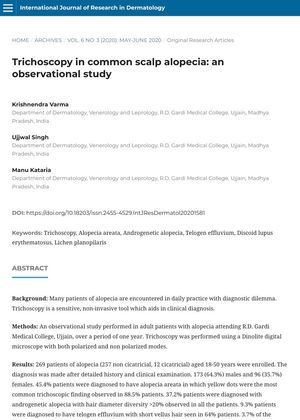Trichoscopy in Common Scalp Alopecia: An Observational Study
April 2020
in “
International Journal of Research in Dermatology
”

TLDR Trichoscopy is a reliable method for diagnosing different types of hair loss.
In the observational study conducted by Krishnendra Varma, Ujjwal Singh, and Manu Kataria at R.D. Gardi Medical College, Ujjain, India, 269 patients with alopecia aged 18-50 years were examined using trichoscopy, a non-invasive diagnostic tool, over a period of one year. The study found that 45.4% of patients were diagnosed with alopecia areata, with yellow dots being the most common trichoscopic finding in 88.5% of these patients. Androgenetic alopecia was diagnosed in 37.2% of patients, all of whom showed hair diameter diversity >20%. Telogen effluvium was diagnosed in 9.3% of patients, with short vellus hair seen in 64% of these cases. Seborrheic dermatitis, lichen planopilaris, and discoid lupus erythematosus were diagnosed in 3.7%, 2.9%, and 0.9% of patients respectively. The study concluded that trichoscopy is a reliable diagnostic tool for hair and scalp disorders and should be used in every case of alopecia.


